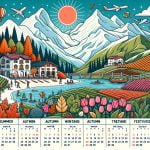Italy, a country steeped in history, culture, and natural beauty, offers travelers a diverse range of experiences to explore. From the rolling vineyards of Tuscany to the picturesque canals of Venice and the ancient ruins of Rome, Italy’s regions are as varied as they are stunning. One crucial consideration for any traveler planning a visit to this Mediterranean jewel is timing – knowing the best months to travel Italy can make all the difference in your experience.
In this article, we will delve into the different aspects of traveling through Italy, from weather patterns and peak tourist seasons to off-peak advantages and ideal times for sightseeing. Understanding these factors can help you plan a trip that maximizes your enjoyment while minimizing inconveniences such as crowds or unfavorable weather conditions.
Whether you’re looking to immerse yourself in Italian culture at festivals or simply relax on the Amalfi Coast, knowing when to go can vastly enhance your travel experience.
By exploring each region’s unique attractions and seasonal nuances, readers will gain valuable insights into when and where to visit in Italy. From budget travel tips to recommendations for seasonal activities like skiing in the Alps or swimming along the Amalfi Coast, this guide aims to provide a comprehensive overview of how to make the most of your Italian journey.
So pack your bags, grab a map, and let’s embark on an adventure through one of Europe’s most captivating destinations – Italia.
Weather and Climate Overview
Italy’s climate is as diverse as its regions, with variations from the northern Alps to the southern coast. Understanding the weather patterns can greatly impact your travel experience and enjoyment of this beautiful country. In general, Italy experiences a Mediterranean climate, characterized by hot, dry summers and mild, wet winters. However, the north tends to have cooler temperatures compared to the south due to its proximity to the Alps.
The best months to travel Italy largely depend on what type of activities you plan on doing and which regions you want to explore. If you prefer milder temperatures and smaller crowds, consider visiting in the shoulder seasons of spring (April-May) or fall (September-October).
During these months, you can still enjoy pleasant weather while avoiding the peak tourist season. On the other hand, if you are looking for beach weather in Southern Italy or want to experience winter sports in the Alps, then summer and winter might be more suitable for your travel plans.
| Region | Best Months to Visit |
|---|---|
| Northern Italy (Milan, Venice) | April-May & September-October |
| Central Italy (Rome, Florence) | March-June & September-October |
| Southern Italy (Naples, Sicily) | May-June & September-October |
By aligning your travel plans with the best months to visit each region based on your preferences and interests, you can make the most of your time exploring all that Italy has to offer.
Peak Tourist Seasons
When planning a trip to Italy, it’s essential to consider the peak tourist seasons to avoid overcrowded attractions and higher prices. The busiest months in Italy typically coincide with the summer season, from June to August. During this time, popular cities like Rome, Florence, and Venice can be packed with tourists, making it challenging to fully appreciate the beauty and charm of these destinations. To dodge the crowds, it is recommended to plan your visit during the shoulder seasons.
To make the most of your Italian adventure without feeling overwhelmed by throngs of tourists, consider traveling during the spring or fall months. April, May, September, and October are generally regarded as the best months to travel Italy for pleasant weather and fewer crowds. During these times, you can enjoy comfortable temperatures, blooming landscapes, and shorter lines at famous attractions.
Additionally, choosing to visit Italy during the off-peak season can also provide a more authentic experience of Italian culture and lifestyle. Exploring local markets or dining at traditional trattorias becomes more enjoyable when you can interact with locals without being surrounded by hordes of tourists. By opting for a trip during the quieter months, you can savor the essence of Italy while avoiding long queues and crowded tourist hotspots.
Off-Peak Season Advantages
One of the best ways to truly experience and enjoy Italy without the crowds is by traveling during the off-peak season. During these quieter months, you can have a more authentic and immersive experience as you explore the country’s rich culture, stunning landscapes, and delicious cuisine. Let’s dive into some of the advantages of traveling to Italy during these quieter times.
Less Crowds, More Authenticity
Traveling to Italy during the off-peak season means you’ll encounter significantly fewer tourists at popular attractions and landmarks. This allows you to soak in the beauty of iconic sites like the Colosseum in Rome or the canals of Venice without feeling overcrowded. Additionally, interacting with locals becomes easier as they have more time to engage with visitors and share their traditions and stories, providing a more authentic cultural experience.
Lower Prices and Better Deals
Another major advantage of visiting Italy during the off-peak season is that you can often find better prices on accommodations, transportation, and activities. Many hotels and tour companies offer discounts during these quieter months to attract visitors, allowing you to save money while still enjoying all that Italy has to offer. Additionally, restaurants may have special promotions or set menus that make dining out more affordable.
Unique Regional Experiences
Traveling during off-peak months gives you the opportunity to discover lesser-known gems and hidden treasures in Italy’s diverse regions. You can take leisurely strolls through charming villages in Tuscany, taste authentic street food in Naples, or explore the picturesque countryside of Umbria without feeling rushed or overwhelmed by other tourists. Embracing these unique regional experiences will give you a deeper appreciation for Italy’s rich history and culture.
Overall, choosing to visit Italy during its off-peak season can provide numerous benefits that enhance your travel experience. From avoiding crowds at popular tourist sites to saving money on accommodations and enjoying unique regional experiences, traveling during quieter months allows you to savor all that this beautiful country has to offer at a more relaxed pace. Consider planning your trip outside of peak tourist seasons for a truly unforgettable Italian adventure.
Best Months for Sightseeing
Italy is a country rich in history, culture, and stunning landmarks that attract millions of tourists every year. When planning a trip to this beautiful country, it’s essential to consider the best months to visit to make the most of your sightseeing experience. From iconic monuments to charming villages, Italy offers something for every traveler’s taste.
Spring: March-May
Spring is undoubtedly one of the best times to visit Italy for sightseeing. The weather is mild, with blooming flowers and budding trees adding a touch of beauty to the already picturesque landscapes. This season allows visitors to explore famous landmarks such as the Colosseum in Rome, the canals of Venice, and the ruins of Pompeii without the scorching heat and overwhelming crowds of summer.
Fall: September-November
Another ideal time for sightseeing in Italy is during the fall months. The weather remains pleasant, making it comfortable to wander through historic sites and take in the changing colors of autumn. Popular attractions like the Leaning Tower of Pisa, Florence’s Duomo, and Milan’s Cathedral are less crowded during this time, allowing for a more relaxed exploration experience.
Winter: December-February
While winter may not be the traditional peak season for tourism in Italy, it can be an excellent time for sightseeing if you prefer fewer crowds and lower prices. Landmarks like the Vatican City and the Sistine Chapel in Rome are often less busy during winter months, providing an opportunity for a more intimate experience with these cultural treasures.
Plus, experiencing Italian cities decorated for Christmas adds an extra layer of charm to your sightseeing adventures. Consider visiting ski resorts in Northern Italy if you’re looking for a mix of sightseeing and winter sports during this time.
Festivals and Events
Italy is not only known for its stunning landscapes and architectural wonders but also for its vibrant cultural celebrations throughout the year. From religious festivals to colorful carnivals, there is always something happening in Italy regardless of the season. Here are some of the most exciting cultural events that take place in Italy:
- Carnevale: One of the most famous events in Italy is Carnevale, a spectacular festival celebrated in February or March, depending on the lunar calendar. Venice is renowned for its elaborate masks and costumes during this time, drawing visitors from around the world to participate in the festivities.
- Palio di Siena: Held twice a year in July and August, this historic horse race takes place in Siena’s main square, Piazza del Campo. Dating back to medieval times, the Palio di Siena is a thrilling event that showcases fierce competition among ten of Siena’s contrade (districts).
- Infiorata di Noto: In late spring, the town of Noto in Sicily becomes a canvas for floral art during the Infiorata festival. Local artists create intricate designs using flower petals along the town’s streets, creating a stunning display of colors and patterns.
These are just a few examples of Italy’s rich cultural heritage that come alive during various festivals and events throughout the year. Whether you’re interested in music, art, food, or history, there’s something for everyone to enjoy while immersing yourself in Italian culture.
Remember to check the dates of these festivals and plan your trip accordingly to make sure you don’t miss out on these unique and unforgettable experiences. Embrace the lively atmosphere and join locals in celebrating traditions that have been passed down through generations, adding an extra layer of authenticity to your Italian adventure.
Seasonal Activities
Italy offers a wide range of seasonal activities, making it an attractive destination year-round. During the winter months, from December to March, skiing in the Alps is a popular choice for outdoor enthusiasts. The Italian Alps boast world-class ski resorts with breathtaking views and excellent slopes for all levels of skiers. Whether you are a beginner or an experienced skier, there are options available to suit your preferences.
On the other end of the spectrum, in the summertime from June to August, visitors can enjoy swimming along the stunning Amalfi Coast. With its crystal-clear waters and picturesque beaches, this region is perfect for sun-seekers looking to relax and unwind. The Amalfi Coast also offers opportunities for water sports such as snorkeling and diving, allowing tourists to explore the vibrant marine life in the Mediterranean Sea.
For those looking for a more active vacation experience, hiking in the Dolomites during the shoulder seasons of spring (April to May) or fall (September to October) can be a rewarding adventure. The Dolomites offer a network of trails that cater to hikers of all abilities, providing stunning views of rugged peaks and lush valleys. Whether you prefer leisurely strolls or challenging treks, exploring the Dolomites is a memorable way to immerse yourself in Italy’s natural beauty.
| Seasonal Activity | Best Months |
|---|---|
| Skiing in the Alps | December – March |
| Swimming on the Amalfi Coast | June – August |
| Hiking in the Dolomites | April – May / September – October |
Budget Travel Tips
When it comes to planning a trip to Italy, timing can make a significant difference in your overall experience. Understanding the best months to travel Italy can not only help you avoid crowds but also save money while exploring this beautiful country. By taking into consideration factors like weather, peak tourist seasons, and unique events happening throughout the year, you can tailor your trip to suit your preferences and budget.
One of the main advantages of traveling during off-peak seasons in Italy is the opportunity to enjoy lower prices on accommodations, activities, and even flights. The months outside of the peak tourist season not only offer more affordable options but also provide a more relaxed and authentic experience of Italian culture.
Whether you choose to explore the charming streets of Florence in November or enjoy the stunning beaches of Sicily in April, traveling during off-peak months allows you to enjoy all that Italy has to offer without breaking the bank.
In conclusion, finding the best months to travel Italy depends on your personal preferences and travel goals. While some may prefer the vibrant atmosphere of summer festivals or the festive holiday season, others might enjoy a quieter visit during shoulder seasons.
By considering factors such as weather, crowds, special events, and budget-friendly tips, you can create a memorable Italian adventure that suits your individual needs. Whether you’re exploring ancient ruins in Rome or savoring delicious cuisine in Tuscany, Italy offers something special year-round for every type of traveler.
Frequently Asked Questions
What Is the Cheapest Month to Go to Italy?
The cheapest month to go to Italy is typically November. During this time, you can find lower prices on accommodations and flights due to it being the off-peak tourist season. It’s a great opportunity to save money while enjoying the beauty of Italy.
What 3 Months Are the Warmest in Italy?
The three warmest months in Italy are June, July, and August. These summer months usually bring high temperatures and plenty of sunshine across the country. It’s the perfect time to enjoy the beaches, outdoor activities, and al fresco dining that Italy has to offer.
What Is the Rainiest Month in Italy?
The rainiest month in Italy tends to vary depending on the region. However, generally speaking, October is known for experiencing more rainfall compared to other months. This is considered part of the autumn season when you may encounter more wet weather, so be sure to pack accordingly if you plan on visiting during this time.

I’m a passionate traveler, writer, and Italophile. My fascination with Italy’s history, art, and culture has led me on countless adventures across the Italian landscape. Through “I Live Italy,” I share my love for this extraordinary country and aims to inspire others to explore its boundless beauty.





